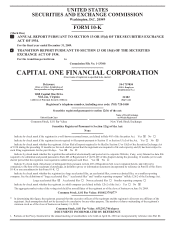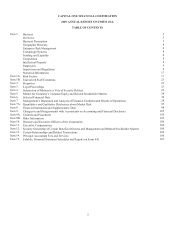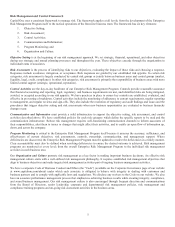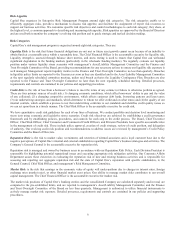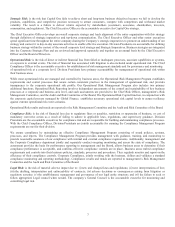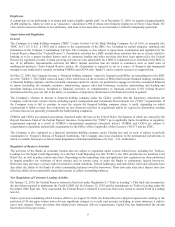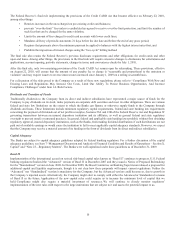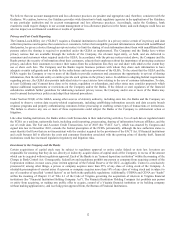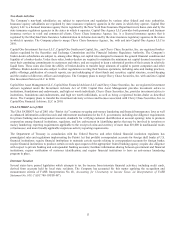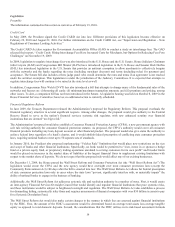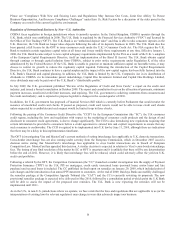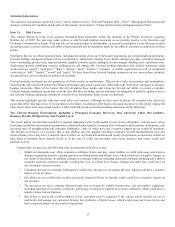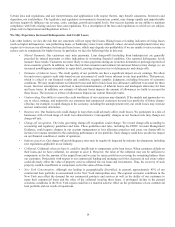Capital One 2009 Annual Report Download - page 24
Download and view the complete annual report
Please find page 24 of the 2009 Capital One annual report below. You can navigate through the pages in the report by either clicking on the pages listed below, or by using the keyword search tool below to find specific information within the annual report. 11
Deposits and Deposit Insurance
Each of the Banks, as an insured depository institution, is a member of the Deposit Insurance Fund (“DIF”) maintained by the FDIC.
Through the DIF, the FDIC insures the deposits of insured depository institutions up to prescribed limits for each depositor. The DIF
was formed on March 31, 2006, upon the merger of the Bank Insurance Fund and the Savings Association Insurance Fund in
accordance with the Federal Deposit Insurance Reform Act of 2005 (the “Reform Act”). The Reform Act permits the FDIC to set a
Designated Reserve Ratio (“DRR”) for the DIF. To maintain the DIF, member institutions may be assessed an insurance premium and
the FDIC may take action to increase insurance premiums if the DRR falls below its required level.
The FDIC has established a plan to restore the DIF in the face of recent insurance losses and future loss projections. As such, in the
past year, the FDIC has issued rules that generally increase deposit insurance rates and are expected to improve risk differentiation so
that riskier institutions bear a greater share of insurance premiums. As part of the restoration plan, the FDIC imposed a five basis point
special assessment on a bank’s assets minus its Tier 1 capital as of June 30, 2009. The FDIC recently increased annual assessment
rates again by three basis points beginning 2011. The FDIC also recently issued a final rule that required banks to prepay on
December 31, 2009 their estimated quarterly risk-based assessment for the fourth quarter of 2009 and for 2010, 2011, and 2012. In
connection with the rule, the Company has prepaid approximately $700 million, which is included within Other Assets.
On October 14, 2008, the FDIC announced its Temporary Liquidity Guarantee Program (“TLGP”), which included the Transaction
Account Guarantee Program (“TAGP”). The TAGP provides unlimited deposit insurance coverage for non-interest bearing transaction
accounts (including accounts swept from a non-interest bearing transaction account into a non-interest bearing savings deposit
account) and certain interest-bearing accounts (negotiable order of withdrawal (NOW) accounts with interest rates of 0.5 percent or
less and lawyers trust accounts) at FDIC-insured depository institutions. The TAGP was originally scheduled to expire on
December 31, 2009, but was extended through June 30, 2010 for those institutions that choose to participate. The Banks are
participating in the TAGP extension. Extension assessment costs are an annualized 15 basis point fee on the balance of each covered
account in excess of the current FDIC insurance limit of $250,000.
The FDIC is authorized to terminate a bank’s deposit insurance upon a finding by the FDIC that the bank’s financial condition is
unsafe or unsound or that the institution has engaged in unsafe or unsound practices or has violated any applicable rule, regulation,
order or condition enacted or imposed by the bank’s regulatory agency. The termination of deposit insurance for a bank could have a
material adverse effect on its liquidity and its earnings.
Banks may accept brokered deposits as part of their funding. Under the Federal Deposit Insurance Corporation Improvement Act of
1991 (“FDICIA”), as discussed in Item 7 “Management Discussion and Analysis of Financial Condition and Results of Operations—
Section X. Capital”, only “well-capitalized” and “adequately-capitalized” institutions may accept brokered deposits. Adequately-
capitalized institutions, however, must first obtain a waiver from the FDIC before accepting brokered deposits, and such deposits may
not pay rates that significantly exceed the rates paid on deposits of similar maturity from the institution’s normal market area or, for
deposits from outside the institution’s normal market area, the national rate on deposits of comparable maturity.
Overdraft Protection
The Federal Reserve amended Regulation E on November 12, 2009, to limit the ability to assess overdraft fees for paying ATM and
one-time debit card transactions that overdraw a consumer’s account, unless the consumer opts into such payment of overdrafts. The
new rule does not apply to overdraft services with respect to checks, ACH transactions, or recurring debit card transactions, or to the
payment of overdrafts pursuant to a line of credit or a service that transfers funds from another account. We are required to provide to
customers written notice describing our overdraft service, fees imposed, and other information, and to provide customers with a
reasonable opportunity to opt in to the service. Before we may assess fees for paying discretionary overdrafts, a customer must
affirmatively opt in, which could negatively impact our deposit business revenue.
Liability for Commonly-Controlled Institutions
Under the “cross-guarantee” provision of the Financial Institutions Reform, Recovery and Enforcement Act of 1989 (“FIRREA”),
insured depository institutions such as the Banks may be liable to the FDIC with respect to any loss incurred or reasonably anticipated
to be incurred, by the FDIC in connection with the default of, or FDIC assistance to, any commonly controlled insured depository
institution. The Banks are commonly controlled within the meaning of the FIRREA cross-guarantee provision.
FFIEC Account Management Guidance
On January 8, 2003, the Federal Financial Institutions Examination Council (“FFIEC”) released Account Management and Loss
Allowance Guidance (the “Guidance”). The Guidance applies to all credit lending of regulated financial institutions and generally
requires that banks properly manage several elements of their lending programs, including line assignments, over-limit practices,
minimum payment and negative amortization, workout and settlement programs, and the accounting methodology used for various
assets and income items related to loans.


